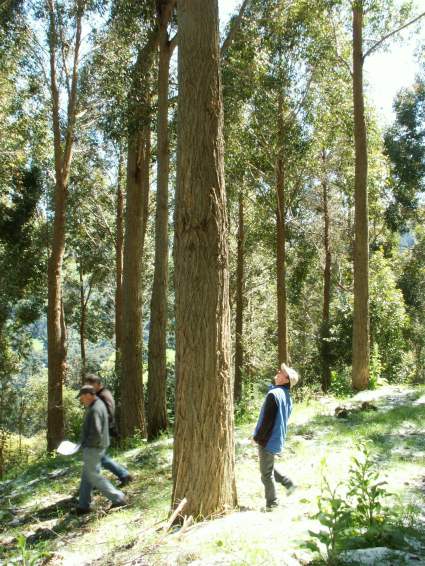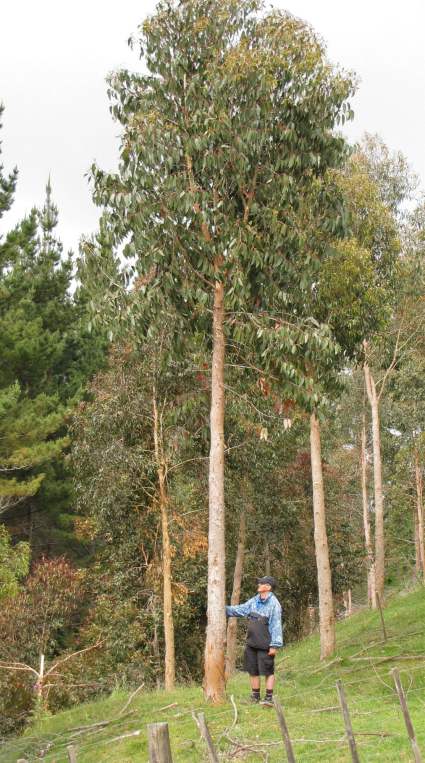Progress with hardwood forestry
Dean Satchell, New Zealand Tree Grower May 2013.
The Sustainable Farming Fund-backed work of the Eucalyptus Action Group and farm foresters are producing promising results. Trees from research packs planted 10 years ago around New Zealand are providing an important insight into stringybark eucalypt selection and siting. We now know that stringybark species grow well throughout much of New Zealand.
Why stringybark eucalypts?
Stringybark eucalypts produce a premier hardwood timber. It saws well with very little stress, dries readily with little shrinkage or distortion and has excellent machining properties. This medium-density timber is stable in service and has very good surface hardness for applications such as flooring, along with good durability for applications including untreated decking and outdoor furniture.
The timber is synonymous with the blackbutt Eucalyptus pilularis, and is used for the same applications.The sapwood band is resistant to lyctus borer and is very narrow at only one to two centimetres, an important but often overlooked quality of these species.An additional bonus is that little colour change occurs between heartwod and sapwood, so for internal applications sapwod can be included.These are a lot of positive qualities for a fast growing plantation species.
Stringybark eucalypts and forestry
What do we know about stringybark eucalypts? Some of the most impressive eucalypts I have seen in New Zealand have been stringybarks. Large straight 100-year-old barrels, with the fifth log still well over a metre in diameter and branchless − a sawmiller’s dream.

Stringybarks have similar soil requirements to radiata pine and like moderate soil fertility with reasonable drainage.They establish especially well in pine cut-over, possibly because of existing soil micorrhiza. Despite New Zealand's long history of eucalypt pests emigrating from Australia, stringybarks remain very healthy. Even the foliar diseases which have drifted across the Tasman Sea cause no problems.These are the survivors, the pick of the bunch. We have learned this from experience, the same experience that has taught us to stay clear of many others.
Siting and selection
A total of 25 or so stringybark species are found across a wide climatic range in Australia. Understanding how these species adapt to our own climatic variables and extremes was the purpose of the research packs.A process of elimination has narrowed the choice down to species which all perform well in terms of growth, but each with its own climatic niche. For example E. youmanii has proved to be extremely cold-hardy while E. muelleriana enjoys warmth and humidity. E. macrorhyncha is very cold hardy but requires a dry climate. Detailed information will follow in a separate article.
Fortunately, timber properties are consistent between species, so for marketing purposes these timbers can be grouped together.This means we could be growing a consistent and high-value hardwood timber in every region of New Zealand, an opportunity the forest industry should not dismiss lightly.
The future
The demand for hard, strong, durable hardwood in New Zealand is well ahead of supply, with prices reflecting the depletion of tropical rainforests and Northland’s ‘old growth’ blackbutt eucalypt resource. There is an opportunity for plantation hardwoods to fill this void, but growers require confidence in the likelihood of their plantation’s success. Can we grow stringybarks well? Although data is lacking and research has been piecemeal, foresters do have the opportunity to take advantage of a long history of observation and anecdotes around these species in New Zealand. As the pieces continue to fit into the puzzle we can hope that growers’ confidence improves.Thanks to the work of Ian Nicholas and Angus Gordon launching the eucalypt research packs ten years ago, along with Ruth McConnochie from Scion planting parallel stringybark trials, we now have some basic data to work with.

The Eucalyptus Action Group is currently being supported by the Sustainable Farming Fund to evaluate the data from over 50 research pack plantings using GIS maps. This work will lead to development of basic siting guidelines for stringybark species around New Zealand, with a regional focus.
Continuing work needed
However, this does not mean that the job is done and it is now time to relax.We have a sound basis for extending our knowledge and improving these guidelines.With enough sample plots producing growth data we might even be able to make an economic case for plantation hardwoods and for an industry to emerge.
The NZFFA cannot rely on others to do the work for us. This means that as growers, we need to −
- Continue planting trials and blocks of trees
- Actively record and archive data − the NZFFA website is now set up for this, allowing users to record, access and edit data
- Be able to measure our trees as sample plots – the NZFFA action groups have jointly purchased a vertex instrument which is available to members.
This is not rocket science. The more growth data we can get, the greater the level of confidence we will have in our recommendations.
The Eucalypt Action Group is coordinating an annual planting programme beginning this year for interested growers. Seedlings from six selected high-performing seedlots will be available for spring planting, matched to region and site. We encourage growers to participate and contribute to the forward progress we are making with these species.
For more information or if you want to be involved in the next generation of Eucalyptus Action Group stringybark trials, contact Angus Gordon 06 388 1571 angusg@xtra.co.nz or Dean Satchell 09 407 5525 dsatch@gmail.com

 Farm Forestry New Zealand
Farm Forestry New Zealand

